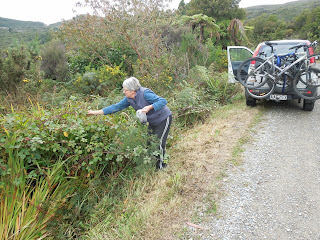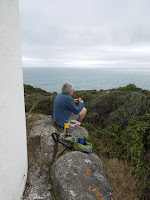One of our books ‘The Great Kiwi Road Trip’ lists our next destination as a hidden gem - Sylvia Flats. We have been here before and it really is a gem, hot thermal water running into the Lewis River. I had read though that this area was now closed because of a slip but we still thought it was worth checking out for ourselves. There was always the possibility that this had been remedied. The turn off into this once picnic area is about 2km from Boyle Village but of course we were coming from the other direction so it was tricky. Luck was on our side, with no other vehicles behind us, we spotted the track and turned in. A quick walk to along to the river confirmed that the area was still in fact dangerous and it looked like no one had been digging out a pool for themselves in recent times. We decided to stay the night in the area anyway as it was very picturesque beside the river and we were well out of the way of the slip. It was surprising the number of vehicles that came in for a look even in the short time we were there.
 |
| Stephen soaking in the pool alongside the Lewis River. |
However luck was to be on our side. Later on in the evening another van came in and joined us and it was still there when we went to bed. We were nearly asleep when our company called out to us that he had dug out a pool if we wanted to join him. We declined but said we would look it out in the morning. I don’t think he had been in it all night but he was definitely there again first thing in the morning, enjoying his own private thermal pool. A short discussion re the safety etc of the area had us decide we would be back after breakfast. Evidently the slip came down during a flood two and a half years ago, and our friend had been there at the time. He said he had been monitoring the site since then and decided that there had been no movement in over a year now and deemed that he was prepared to take a risk. He had fashioned out an excellent sized pool and the water temperature was just perfect. The only complaint were those dammed sandflies again otherwise it was perfect. As the book says ‘a hidden gem’ but now obviously it comes with a certain amount of risk. We thought it was worth it.
 |
| A view of the slip caused by flooding in November 2011. |
























































